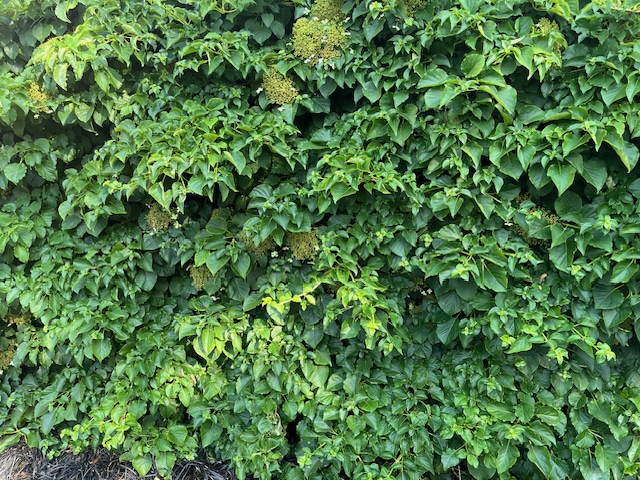Description
Garden Advice Notes
Hydrangea petiolaris, also known as the climbing hydrangea, is a deciduous, woody climber prized for its ability to cover walls, fences, and even large tree trunks with lush, attractive foliage and showy blooms. Native to the woodlands of Asia, this hydrangea thrives in cooler climates and is ideal for adding vertical interest to shaded areas of the garden.
It features heart-shaped, deep green leaves that create a dense cover through spring and summer. In early to midsummer, it produces large, flattened clusters of creamy white, lace-cap-like flowers that can reach up to 8–10 inches across. These flowers are particularly attractive to pollinators and provide a striking display against the rich green foliage.
Hydrangea petiolaris climbs by means of aerial roots, which allow it to attach itself to surfaces without the need for support wires. It is a slow starter but becomes vigorous once established and can eventually reach up to 40 feet in height and 6–10 feet in spread.
Soil Type
Hydrangea petiolaris prefers moist, well-drained, humus-rich soil. It thrives in neutral to slightly acidic conditions (pH 5.5 to 7.0), although it can tolerate a range of soil types if drainage is adequate.
-
Improve heavy clay or sandy soils with plenty of organic matter such as leaf mould or composted bark.
-
Avoid waterlogged conditions, particularly in winter, as this can cause root rot.
-
A mulch of compost or leaf mould in spring helps retain moisture and feeds the plant throughout the season.
Location
This climbing hydrangea performs best in partial to full shade, making it an excellent choice for north- or east-facing walls. It is ideal for:
-
Shaded walls, fences, and large trees
-
Woodland gardens or shaded courtyards
-
Areas where other climbers may struggle due to lack of sunlight
While it tolerates sunnier locations in cooler climates, too much direct sun can scorch the foliage.
Pest and Disease Problems
Hydrangea petiolaris is generally pest- and disease-resistant but may occasionally experience:
-
Aphids – These can cause leaf curling or distortions but are usually controlled by birds or beneficial insects.
-
Scale insects – These can appear on older stems and be treated with horticultural oil.
-
Powdery mildew – May occur in dry, still air; improve air circulation and avoid overhead watering.
-
Leaf spot – Fungal leaf spots may appear in wet summers; remove affected leaves to reduce spread.
Regular monitoring and prompt removal of damaged foliage help maintain the plant’s health.
Propagation
Hydrangea petiolaris can be propagated by layering or softwood cuttings.
-
Layering: In spring or early autumn, select a low-growing shoot, wound it slightly, and peg it down into the soil. Roots should form over several months, after which it can be severed and replanted.
-
Cuttings: Take softwood cuttings in early summer. Use non-flowering shoots and root them in a moist, well-draining propagation mix under cover.
While propagation is relatively straightforward, rooted layers and cuttings may take a few seasons to develop into mature, flowering plants.
Pruning, Cutting Back and Dividing
Hydrangea petiolaris requires minimal pruning but benefits from occasional maintenance to control size and encourage flowering.
-
Pruning: Prune immediately after flowering if size control is needed. Remove dead, damaged, or congested stems to promote air circulation and new growth.
-
Cutting back: For older plants, rejuvenate by cutting back one-third of the oldest stems to the base in late summer or autumn.
-
Dividing: As a woody climber, Hydrangea petiolaris is not typically divided. Use propagation methods like layering or cuttings instead.
Once established, Hydrangea petiolaris requires little care and will provide reliable structure and floral interest in shaded areas for many years.
Please note our plants in most instances are delivered by our own GardenAdvice expert gardeners. Please note we only supply plants to GardenAdvice members and clients
Our plants are guaranteed for 24 months for more details Click Here
























Reviews
There are no reviews yet.